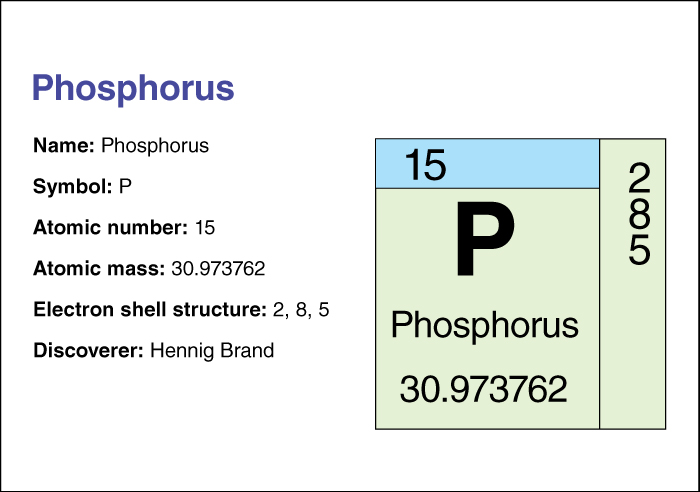Phosphorus, << FOS fuhr uhs, >> is a nonmetallic chemical element. It is found in every living cell. Phosphorus also has many industrial uses. In nature, phosphorus occurs only in compounds called phosphates.

Plants and animals need phosphorus to live, as well as for normal growth. Plants absorb phosphorus from soil. They use it in photosynthesis, the process by which plants use sunlight to produce food. People and animals take in phosphorus by eating plants. Such foods as meat, milk, and eggs also provide phosphorus. About four-fifths of the phosphorus in the human body occurs in the bones and teeth. Phosphorus makes up an important part of adenosine triphosphate (ATP). ATP is a compound that stores energy in body tissues.
A chief source of phosphorus for industrial use is phosphate rock, also called phosphorite. The countries that mine phosphate rock include China, Morocco, and the United States. Manufacturers make two forms of phosphorus from phosphate rock. These forms are white phosphorus and red phosphorus. They are called allotropes of phosphorus (see Allotropy ).
White phosphorus is a soft, waxy solid. To prepare it, manufacturers first produce phosphorus vapor. They make the vapor by heating phosphate rock in the presence of coke and sand. The vapor is then condensed into white phosphorus. White phosphorus combines readily with other elements. It also spontaneously ignites in air at about room temperature. For this reason, white phosphorus is usually stored underwater. White phosphorus is poisonous. When touched, it can cause serious burns. It is also phosphorescent. That means that it glows in the dark when exposed to air. Manufacturers use white phosphorus in making steel and plastics. White phosphorus is used in animal feed, drugs, fertilizers, insecticides, and water softeners. White phosphorus also serves as the active ingredient in some incendiary (fire-causing) devices, such as grenades and signal flares. Detergents made with white phosphorus are rich in phosphates. But phosphates from the detergents can enter lakes and rivers through sewage. They can contribute to the eutrophication of the lakes and rivers. Eutrophication results in the death of fish and other aquatic life (see Eutrophication ).
Red phosphorus is made by heating white phosphorus or by exposing it to sunlight. Red phosphorus is a brownish-red powder. It does not burn as readily as white phosphorus. It also does not combine as easily with other elements. Red phosphorus is used in the production of safety matches and pesticides.
Another allotrope of phosphorus, called black phosphorus, resembles graphite. It can be made by heating white phosphorus under high pressure. Black phosphorus combines less readily with other elements than do white and red phosphorus.
Phosphorus has the chemical symbol P. Its atomic number (number of protons in its nucleus) is 15. Its relative atomic mass is 30.973761. An element’s relative atomic mass equals its mass (amount of matter) divided by 1/12 of the mass of an atom of carbon 12, the most abundant form of carbon. White phosphorus melts at 44.1 °C and boils at 280 °C. The German alchemist Hennig Brand discovered phosphorus in 1669.
For information on the position of phosphorus on the periodic table, see the article Periodic table .
